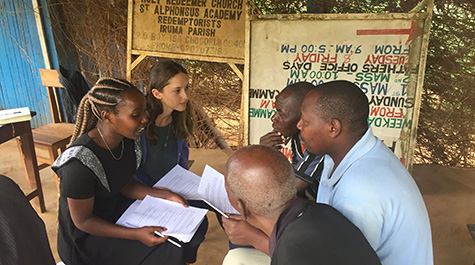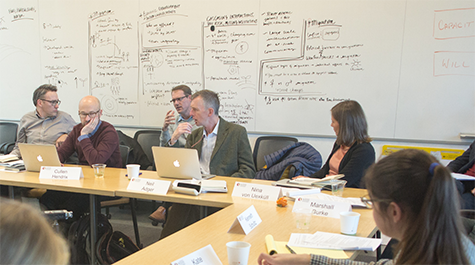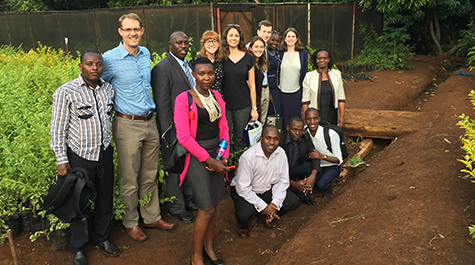In 'Nature': The role of climate change in armed conflict
In the fall of 2016, during the waning months of Barack Obama’s presidency, the White House released a memorandum titled “Climate Change and National Security.”
The memo was a federal mandate to consider the impacts of climate change in the development of national security-related doctrine, policies and plans. It warned that the effects of climate change could lead to “population migration within and across international borders, spur crises, and amplify or accelerate conflict in countries or regions already facing instability and fragility.”
But exactly what size role does climate change play in civil unrest? A new study aims to find out. The consensus among experts featured in the study is that climate change is often an important contributing factor in the outbreak of armed conflict, but economic, political and social issues often overshadow it.
The experts also say that the impacts of climate change can fan smoldering conflicts into all-out conflagrations. Further, the paper warns that as the negative environmental effects on agriculture, water and other necessities increase, climate change could become a more important cause of armed strife.
The study, “Climate as a risk factor for armed conflict,” was published today in the journal Nature. The paper features analysis from 11 climate and conflict experts from fields such as political science, environmental science and economics. Philip Roessler, associate professor of government at William & Mary and co-director of the Center for African Development, is one of the experts and co-authors on the paper.
The expert elicitation was spearheaded by Katharine Mach at Stanford University’s Woods Institute for the Environment with the goal of assembling experts with divergent views to assess the impact of climate change on armed conflict to date and over the next century.
“This represents the key innovation of our methodology and contribution,” Roessler said. “It brought together an interdisciplinary group of scholars with different perspectives on this important question.”
The experts systematically read nearly all scholarship written on the climate change-conflict connection and independently assessed the impact of climate change on conflict risk, Roessler explained. Then the group of experts participated in six to eight-hour individual interviews followed by a two-day group deliberation.
While the experts agree that climate has affected organized armed conflict in recent decades, they make clear that other factors, such as low socioeconomic development, the strength of government, inequalities in societies and a recent history of violent conflict, are “substantially more influential” than climate change in driving conflict to date.
“Existing scholarship has tended to study the impact of climate change on conflict in isolation of other conflict drivers,” Roessler said. “This is problematic in assessing the relative effects of climate variability versus other causes of civil war, such as low socio-economic development or group inequality.”
Consider the case of the 2003 outbreak of the Darfur civil war, which Roessler has studied extensively during almost two years of fieldwork in Sudan and analyzed in his book “Ethnic Politics and State Power in Africa: The Logic of the Coup-Civil War Trap.”
“Many referred to the Darfur civil war as the ‘first climate-change conflict,’” Roessler said. “But while climate variability may have contributed somewhat to conflict risk in the western region of Sudan, the most significant drivers of the conflict were ethno-political exclusion, weak state capabilities and inter-group inequality.”
Darfur may be the first, but it’s not the only intranational conflict driven at least partially by climate change: The experts estimate that three to 20 percent of the risk of violent armed conflict within countries has been influenced by climate over the last century. None of the experts, who all serve as co-authors of the study, ruled out the role of climate in 10 percent of conflict risk.
The study also found that climate change could impact agricultural production, economies, and even inequities among groups, all of which can interact with other conflict drivers to potentially increase risks of violence.
“This is what makes the future scenarios potentially explosive,” Roessler said. “Rising temperatures and irregular rainfall have a direct impact on conflict risk by reducing agricultural yields and increasing the allure of joining an armed group to make a living. But it can also have significant second-order effects, reducing socioeconomic development, further weakening state capabilities and increasing intergroup inequality.”
Roessler says there is an urgent need to identify interventions and policies to prevent the outbreak of war by strengthening communities’ resiliency to climate change. One such intervention is crop insurance. Roessler, supported by a Reves Center Faculty Fellowship, recently returned from Kenya with a group of five W&M undergraduates, where they worked with a research team from Chuka University to study the low number of insured smallholder farms in Mount Kenya.
The project, which the W&M students initiated as part of the Global Research Institute’s Shark Tank competition, aims to better understand how to increase demand and uptake of crop insurance—and its efficacy in reducing climate-induced conflict. It is a topic Roessler and his research team at the Center for African Development will continue to study.
Uncertainty is a key caveat in any discussion about climate change. The mechanisms through which climate affects conflict and under what conditions those mechanisms materialize remains only partially understood, the study states. That said, the paper notes that the experts agree that “intensifying climate change is estimated to increase future risks of conflict.”
Currently, climate variability and change are estimated to have substantially increased risk across five percent of conflicts globally, according to the study. With a global mean temperature increase of two degrees Celsius — the stated goal level of the Paris Climate Agreement — the increased risk of conflict jumps to 13 percent.
The study predicts the influence of climate on conflicts to increase more than five times, leaping to 26 percent, if the Earth reaches four degrees of warming. That’s the predicted level of warming if societies do not substantially reduce emissions, Roessler explained.
“Worsening climate change will make it more difficult for states to collectively prevent and contain conflict,” Roessler said. “Climate change will not only increase conflict risk, but sap our capacity to contain and prevent them.”
The other co-authors on the paper are affiliated with the following institutions: Stanford University, University of Exeter, Peace Research Institute Oslo, Norwegian University of Science and Technology, National Bureau of Economic Research, University of Denver, University of Antwerp, Lancaster University, University of Colorado Boulder, Research Group Climate Change and Security (CLISEC), University of Hamburg and Uppsala University.


















